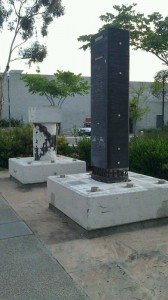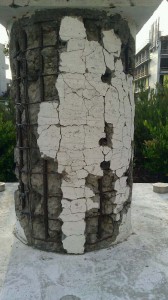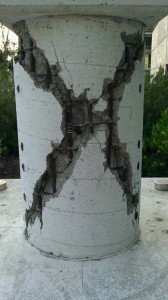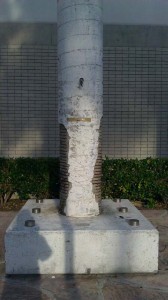Visitors to this part of the UCSD campus won’t forget that California is Earthquake country. Set at the edge of a walkway next to the landscaping are these pillars that have undergone simulated tremors on a jumbo shake table that can deliver a massive series of movements emulating the Big One.
Another hint that this is California lies in the fact that these are pillars modeled on those that keep our freeways high in the air. The structures lab here has worked with transportation agencies to try to develop safer structural components for bridges and overpasses.
During severe shaking the tremendously strong yet fragile concrete disintegrates, leaving the supporting steel which has flexibility but comparatively little strength to keep structures aloft. I wouldn’t want to be anywhere near a freeway with compromised supports like this.
The solution the structural engineers came up with is to wrap the columns in a material that bandages the concrete and keeps it from pulverizing into gravel. It almost seems too obvious a thing to do, but it looks like it really works when you compare these two pillars to the first ones I showed.
So, here in the middle of clipped hedges and mounds of orange lion’s tail, you have these six pillars, standing around like decaying Grecian columns or remnants of a garden folly in an Eighteenth-Century English garden.
This image is of the Temple of Harmony, a folly on the grounds of Halswell House, Goathurst, Somerset, courtesy of the Wikimedia Commons. (Image by Stronach, released to the public domain. Thank you Stronach!) Even though it’s far from this land with the shakes the Temple apparently has some trouble standing up. The Wikipedia description states that “it now has the addition of a tie bar, a long retaining bolt that runs through the structure from one side to the other, helping to keep it together.”
Maybe the Halswell Park Trust could take a clue from the clever Californians and wrap the Temple in fiberglass, though, yeah, it might look a little more like the work of Christo than that of Thomas Prowse, its original architect…











